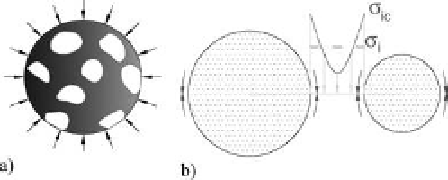Environmental Engineering Reference
In-Depth Information
D
d
p
wn
aw
GG
γ
α
R
=
R
σ
=−
1
µ
p
σ
γ
m
ci
cri
(
−
)
−
γ
R
α
γ
R
3
2(
p
wn
=
L
γ
(7)
τ
=
λ
R
M
G
−
γ
−
)
R
where l
R
is a parameter with longitudinal dimension:
contact can be broken as a result of compres-
sion, traction, shear or a combination of these
three types of stress. By simplification the contact
can be said to break when:
aw
G
R
L
=
σ
Rcri
L
R
and
α
R
depend on:
- the critical strength
σ
cri
;
- the welding coeicient
w
;
- the overlap
a
R
.
p
wn
( )
σ
cri
K
cri
(
1
−
)
R
where
σ
cri
the stress of what ever type will produce
failure.
k
cri
is a function of
λ
and
µ
:
2.2
Rocks with vacuolar pore structures
as previously seen, when a macroporous rock
is subjected to an isotropic external pressure,
p
K
cri
=
K
cri
(
λ
,
µ
)
The
λ
and
µ
coefficients depend on the overlap
of the particles. a high overlap means many con-
tacts and the shear stresses and moments in these
contacts are very small in relation to the normal
components. on the contrary however, in very
open structures with few contacts the moments
and shear stresses increase relatively.
all of these reasons suggest a ratio of the type:
1
σ
i
=
p
1
−
n
v
where n
v
is the vacuolar porosity in this case.
The
σ
i
stress is an average stress.
There are concentrations of circumferential
stresses on the edges of the vacuolas (
Fig. 4
),
which will be larger the closer the vacuolas are and
the larger they are in relation to the intervacuolar
space. Peak stresses,
σ
ic
, on the edge are:
K
cri
=
K
(
n
)
or better still:
KK
n
σ
ic
=
kσ
i
thus
cir
=
1
−
n
The simplest function that can be adopted is:
p
n
σ
ic
=
k
a
1
−
1
n
R
V
K
=
cri
a
1
−
n
R
where
k
is a concentration factor.
The rock will collapse when
σ
ic
reaches a cer-
tain critical value
σ
cri
, which is thought to be
Finally, when external pressure
p
is so big that it
reaches
σ
cri
, the collapse of the macroporous struc-
ture is produced. Thus:
α
R
a wn
n
n
1
−
(6)
(
)
R
p
=
σ
1
−
ci
cruR
R
R
if the specific weight of the intact rock is
G
and the specific weight of the rock with pores is
γ
,
then:
γ
= (1 -
n
R
)
G
subsequently equation (6) can be expressed the
following way:
Figure 4. isotropic compression test (a) Vacuolar
structure. (b) Detail of the intervacuolar stress.






















